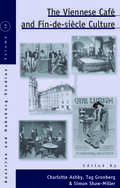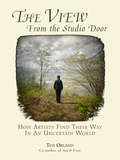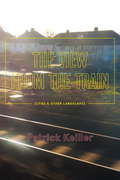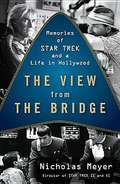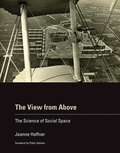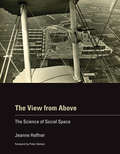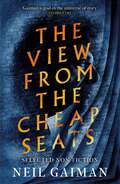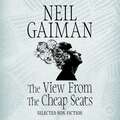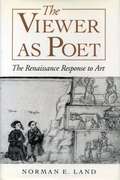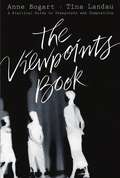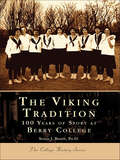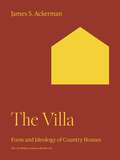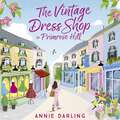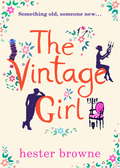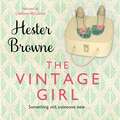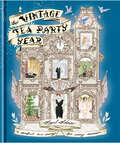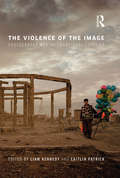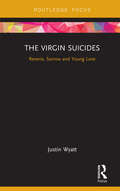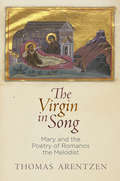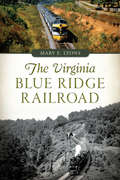- Table View
- List View
The Viennese Cafe and Fin-de-Siecle Culture
by Simon Shaw-Miller Charlotte Ashby Tag GronbergThe Viennese cafe was a key site of urban modernity around 1900. In the rapidly growing city it functioned simultaneously as home and workplace, affording opportunities for both leisure and intellectual exchange. This volume explores the nature and function of the coffeehouse in the social, cultural, and political world of fin-de-siecle Vienna. Just as the cafe served as a creative meeting place within the city, so this volume initiates conversations between different disciplines focusing on Vienna at the beginning of the twentieth century. Contributions are drawn from the fields of social and cultural history, literary studies, Jewish studies and art, and architectural and design history. A fresh perspective is also provided by a selection of comparative articles exploring coffeehouse culture elsewhere in Eastern Europe.
The View From The Studio Door
by Ted OrlandIn the perennial best-seller Art & Fear, Ted Orland (with David Bayles) examined the obstacles that artists encounter each time they enter their studio and stand before a new blank canvas. Now, in The View From The Studio Door, Orland turns his attention to broader issues that stand to either side of that artistic moment of truth.In a text marked by grace, brevity and humor, Orland argues that when it comes to art making, theory and practice are always intertwined. There are timeless philosophical questions (How do we make sense of the world?) that address the very nature of art making, as well as gritty real-world questions (Is there art after graduation?) that artists encounter the moment they're off the starting blocks and producing work on a regular basis.Simply put, this is a book of practical philosophy. As a teacher and working artist himself, Orland brings authentic insight and encouragement to all those who face the challenge of making art in an uncertain world. The breadth of material covered is reflected in chapters that include Making Sense of the World, Art & Society, The Education of the Artist, Surviving Graduation, Making Art That Matters, The Artistic Community, and more.The View From The Studio Door is the perfect companion piece to Art & Fear, and will appeal to a similar (and already-established) audience of students, working artists, teachers and professionals. For students' benefit, The View is also modestly priced, with wide page margins for easy note-taking and annotation.
The View From The Train
by Patrick Keiller"Robinson believed that, if he looked at it hard enough, he could cause the surface of the city to reveal to him the molecular basis of historical events, and in this way he hoped to see into the future." In his sequence of films, Patrick Keiller retraces the hidden story of the places where we live, the cities and landscapes of our everyday lives. Now, in this brilliant collection of essays, he offers a new perspective on how Britain works and sees itself. He discusses the background to his work and its development - from surrealism to post-2008 economic catastrophe - and expands on what the films reveal. Referencing writers including Benjamin and Lefebvre, the essays follow his career since the late 1970s, exploring themes including the surrealist perception of the city; the relationship of architecture and film; how cities change over time, and how films represent this; as well as accounts of cross-country journeys involving historical figures, unexpected ideas and an urgent portrait of post-crash Britain.From the Hardcover edition.
The View From the Bridge: Memories of Star Trek and a Life in Hollywood
by Nicholas MeyerThe critically acclaimed director and writer shares his account of the making of the three classic Star Trek filmsThe View from the Bridge is Nicholas Meyer's enormously entertaining account of his involvement with the Star Trek films: STII: The Wrath of Khan, STIV: The Voyage Home, and STVI: The Undiscovered Country, as well as his illustrious career in the movie business. The man best known for bringing together Sherlock Holmes and Sigmund Freud in The Seven Per-Cent Solution had ironically never been interested in Star Trek until he was brought on board to save the film series. Meyer shares how he created the script for The Wrath of Khan, the most revered Star Trek film of all, in twelve days-only to have William Shatner proclaim he hated it. He reveals the death threats he received when word got out that Spock would be killed, and finally answers the long-pondered question of whether Khan's chiseled chest is truly that of Ricardo Montalban. Meyer's reminiscences on everyone from Gene Roddenberry to Laurence Olivier will appeal not only to the countless legions of Trekkies, but to anyone fascinated by the inner workings of Hollywood.
The View from Above
by Jeanne Haffner Peter GalisonIn mid-twentieth century France, the term "social space" ( l'espace social) -- the idea that spatial form and social life are inextricably linked -- emerged in a variety of social science disciplines. Taken up by the French New Left, it also came to inform the practice of urban planning. In The View from Above, Jeanne Haffner traces the evolution of the science of social space from the interwar period to the 1970s, illuminating in particular the role of aerial photography in this new way of conceptualizing socio-spatial relations. As early as the 1930s, the view from above served for Marcel Griaule and other anthropologists as a means of connecting the social and the spatial. Just a few decades later, the Marxist urban sociologist Henri Lefebvre called the perspective enabled by aerial photography -- a technique closely associated with the French colonial state and military -- "the space of state control." Lefebvre and others nevertheless used the notion of social space to recast the problem of massive modernist housing projects (grands ensembles) to encompass the modern suburb (banlieue) itself -- a critique that has contemporary resonance in light of the banlieue riots of 2005 and 2007. Haffner shows how such "views" permitted new ways of conceptualizing the old problem of housing to emerge. She also points to broader issues, including the influence of the colonies on the metropole, the application of sociological expertise to the study of the built environment, and the development of a spatially oriented critique of capitalism.
The View from Above: The Science of Social Space
by Jeanne HaffnerThe role of aerial photography in the evolution of the concept of social space”and its impact on French urban planning in the mid-twentieth century.In mid-twentieth century France, the term “social space” (l'espace social)—the idea that spatial form and social life are inextricably linked—emerged in a variety of social science disciplines. Taken up by the French New Left, it also came to inform the practice of urban planning. In The View from Above, Jeanne Haffner traces the evolution of the science of social space from the interwar period to the 1970s, illuminating in particular the role of aerial photography in this new way of conceptualizing socio-spatial relations. As early as the 1930s, the view from above served for Marcel Griaule and other anthropologists as a means of connecting the social and the spatial. Just a few decades later, the Marxist urban sociologist Henri Lefebvre called the perspective enabled by aerial photography—a technique closely associated with the French colonial state and military—“the space of state control.” Lefebvre and others nevertheless used the notion of social space to recast the problem of massive modernist housing projects (grands ensembles) to encompass the modern suburb (banlieue) itself—a critique that has contemporary resonance in light of the banlieue riots of 2005 and 2007. Haffner shows how such “views” permitted new ways of conceptualizing the old problem of housing to emerge. She also points to broader issues, including the influence of the colonies on the metropole, the application of sociological expertise to the study of the built environment, and the development of a spatially oriented critique of capitalism.
The View from Babylon: The Notes of a Hollywood Voyeur
by Donald RawleyRawley paints the definitive portrait of Hollywood in the '90s. A lifelong L.A. inhabitant, Rawley takes you on a tour beyond the city's edge - from Malibu's shining white beaches to lonely desert communities to big-studio arenas where life speeds by in "Hollywood time." He introduces a memorable cast of characters - a wistful, recovering methamphetamine addict; a loving father and dedicated ex-soldier driven by heartbreaking failure; the always glamorous, never satisfied Hollywood denizens at one of the industry's "big-big-big" premieres. The View from Babylon is a portrait of the city that reflects our deepest dreams and darkest desires.
The View from Highway 1: Essays on Television
by Michael J. ArlenA series of excellent essays that critique television and society. A highly recommended follow-up read to Arlen's "Living Room War".
The View from the Cheap Seats: Selected Nonfiction
by Neil GaimanThe View from the Cheap Seats draws together myriad non-fiction writing by international phenomenon and Sunday Times bestselling author Neil Gaiman. From Make Good Art, the speech that went viral, to pieces on artists and legends including Terry Pratchett and Lou Reed, the collection offers a glimpse into the head and heart of one of the most acclaimed writers of our time.'If this book came to you during a despairing night, by dawn, you would believe in ideas and hope and humans again' Caitlin Moran'Literature does not occur in a vacuum. It cannot be a monologue. It has to be a conversation' This collection will draw you in to exchanges on making good art and Syrian refugees, the power of a single word and playing the kazoo with Stephen King, writing about books, comics and the imagination of friends, being sad at the Oscars and telling lies for a living. Here Neil Gaiman opens our minds to the people he admires and the things he believes might just mean something - and welcomes us to the conversation too.
The View from the Cheap Seats: Selected Nonfiction
by Neil GaimanThe View from the Cheap Seats draws together myriad non-fiction writing by international phenomenon and Sunday Times bestselling author Neil Gaiman. From Make Good Art, the speech that went viral, to pieces on artists and legends including Terry Pratchett and Lou Reed, the collection offers a glimpse into the head and heart of one of the most acclaimed writers of our time.'Literature does not occur in a vacuum. It cannot be a monologue. It has to be a conversation'Welcome to the conversation. Neil Gaiman fled the land of journalism to find truths through storytelling and sanctuary in not needing to get all the facts right. Of course, the real world continued to make up its own stories around him, and he has responded over the years with a wealth of ideas and introductions, dreams and speeches. Here 'we can meet the writer full on' (Stephen Fry) as he opens our minds to the people he admires and the things he believes might just mean something - and makes room for us to join the conversation too.(P)2016 HarperCollins Digital
The Viewer as Poet: The Renaissance Response to Art
by Norman E. LandThis is a book on Renaissance aesthetics. Renaissance art lovers comment on the famous works of art of their time.
The Viewpoints Book
by Tina Landau Anne BogartThe Viewpoints is a technique of improvisation that grew out of the postmodern dance world. It was first articulated by choreographer Mary Overlie, who broke down the two dominant issues performers deal with--space and time--into six categories. Since that time, directors Anne Bogart and Tina Landau have expanded her notions and adapted them for actors to function together spontaneously and intuitively and to generate bold, theatrical work.The Viewpoints are a set of names given to certain principles of movement through time and space--they constitute a language for talking about what happens on stage. Coupling this with Composition, which is the practice of selecting and arranging the separate components of theatrical language into a cohesive work of art, provides theatre artists with an important new tool for creating and understanding their art form.Primarily intended for the many theatre artists who, in the last several years, have become intrigued with Viewpoints yet have had no single source to refer to in their investigations. It can also be used by anyone with a general interest in collaboration and the creative process, whether in art, business or daily life.Anne Bogart is Artistic Director of the SITI Company, which she founded with Japanese director Tadashi Suzuki in 1992. She is the recipient of two OBIE Awards and a Bessie Award, and is an associate professor at Columbia University. Her recent works include Alice's Adventures; Bobrauschenbergamerica; Small Lives, Big Dreams; Marathon Dancing; and The Baltimore Waltz.Tina Landau, noted director and playwright, whose original work includes Space (Time magazine 10 Best), Dream True (with composer Ricky Ian Gordon) and Floyd Collins (with composer Adam Guettel), which received the Lucille Lortel Award for Best Musical, an OBIE Award and seven Drama Desk nominations. She has been an ensemble member of the Steppenwolf Theatre Company since 1997.
The Viking Tradition: 100 Years of Sports at Berry College (Campus History)
by Susan J. Bandy Ph.D.In 1902, Martha Berry founded the Industrial School for Boys to educate the children of the Southern Appalachian Mountains, and in 1909 the school admitted women. The institution grew from a mountain industrial school to a two-year college in its first twenty-four years, became a four-year college in 1930, and has since become one of the leading liberal arts colleges in the South.This volume portrays, in word and image, the role of sports at Berry College throughout its 100-year history. Situating athletics within the social and cultural life of the college, the book includes both intramural and intercollegiate sport, and traces the evolution of the Viking tradition as it both parallels and reflects the development of sport in the United States. The story begins with the recreational and leisure activities of the early years of the school and traces the continuation of the sporting spirit from the days of the "Silver and the Blue" through the post-war "Blue Jacket" tradition, and ends with the Viking years of the last four decades. Of notable interest in the book is the development of the women's sports program, which has brought four national titles to the college; the importance of soccer to the college; the well-rounded intercollegiate program, which currently fields teams in seven sports; and an excellent intramural program.
The Villa: Form and Ideology of Country Houses (The A. W. Mellon Lectures in the Fine Arts #34)
by James S. AckermanA classic account of the villa—from ancient Rome to the twentieth century—by “the preeminent American scholar of Italian Renaissance architecture” (Architect’s Newspaper)In The Villa, James Ackerman explores villa building in the West from ancient Rome to twentieth-century France and America. In this wide-ranging book, he illuminates such topics as the early villas of the Medici, the rise of the Palladian villa in England, and the modern villas of Frank Lloyd Wright and Le Corbusier. Ackerman uses the phenomenon of the “country place” as a focus for examining the relationships between urban and rural life, between building and the natural environment, and between architectural design and social, cultural, economic, and political forces. “The villa,” he reminds us, “accommodates a fantasy which is impervious to reality.” As city dwellers idealized country life, the villa, unlike the farmhouse, became associated with pleasure and asserted its modernity and status as a product of the architect’s imagination.
The Vintage Dress Shop in Primrose Hill: A sparkling and feel-good romantic read to warm your heart (A Vintage Dress Shop Romance)
by Annie Darling'The sweetest, most delicious book . . . Such a gorgeous love story' Marian Keyes'Funny and heartwarming with great characters' Reader review ⭐⭐⭐⭐⭐'Absolutely gorgeous, swoon worthy romance' Reader review ⭐⭐⭐⭐⭐ 👗Second chances never go out of style...👗 Sophy Stevens always thought she would have everything sorted by the time she was thirty. Instead, she is freshly fired, recently dumped and sleeping on her mum's sofa. So when her absent dad offers her a job at his vintage clothes shop in Primrose Hill, it's one she can't refuse. It will only be for a few months until she is back on her feet, after all.But the Vintage Dress Shop is more magical than she could have even imagined, full of preloved fashion from a 1950s wedding dress to the glittering gems sourced by jeweller Charles. In spite of herself, Sophy starts to fall in love with the store and the process of matching the perfect item with every customer.With each new treasure Sophy uncovers, she begins to wonder if, like these vintage clothes, the store is the key to her second chance... and then there's Charles, who might just end up mending her broken heart...Let Annie Darling sweep you off your feet with this heartwarming and romantic novel, perfect for fans of Katie Fforde and Phillipa Ashley. Everyone is falling in love with Annie Darling:'Heartwarming and compelling. A wonderful read which was difficult to put down... Great characters and a lovely romantic story which touches the heart' Reader review ⭐⭐⭐⭐⭐'The most uplifting, sumptuously indulgent, romantic joy of a book... It tugged all my heartstrings and held me captive until the last, perfect page' Cressida McLaughlin'An absolute delight! I also loved the debonair love interest... It was so nice to see someone pick themselves up and rise from the ashes in such beautiful surroundings surrounded by all these amazing clothes, I loved it!' Reader review ⭐⭐⭐⭐⭐ 'This is the feel good book you must read... With an array of fabulous characters and the perfect ending that made me squeal with delight this warm and charming story will have you enchanted' Nina Pottell
The Vintage Dress Shop in Primrose Hill: A sparkling and feel-good romantic read to warm your heart (A Vintage Dress Shop Romance)
by Annie Darling'The sweetest, most delicious book . . . Such a gorgeous love story' Marian Keyes'Funny and heartwarming with great characters' Reader review ⭐⭐⭐⭐⭐'Absolutely gorgeous, swoon worthy romance' Reader review ⭐⭐⭐⭐⭐ 👗Second chances never go out of style...👗 Sophy Stevens always thought she would have everything sorted by the time she was thirty. Instead, she is freshly fired, recently dumped and sleeping on her mum's sofa. So when her absent dad offers her a job at his vintage clothes shop in Primrose Hill, it's one she can't refuse. It will only be for a few months until she is back on her feet, after all.But the Vintage Dress Shop is more magical than she could have even imagined, full of preloved fashion from a 1950s wedding dress to the glittering gems sourced by jeweller Charles. In spite of herself, Sophy starts to fall in love with the store and the process of matching the perfect item with every customer.With each new treasure Sophy uncovers, she begins to wonder if, like these vintage clothes, the store is the key to her second chance... and then there's Charles, who might just end up mending her broken heart...Let Annie Darling sweep you off your feet with this heartwarming and romantic novel, perfect for fans of Katie Fforde and Phillipa Ashley. Everyone is falling in love with Annie Darling:'Heartwarming and compelling. A wonderful read which was difficult to put down... Great characters and a lovely romantic story which touches the heart' Reader review ⭐⭐⭐⭐⭐'The most uplifting, sumptuously indulgent, romantic joy of a book... It tugged all my heartstrings and held me captive until the last, perfect page' Cressida McLaughlin'An absolute delight! I also loved the debonair love interest... It was so nice to see someone pick themselves up and rise from the ashes in such beautiful surroundings surrounded by all these amazing clothes, I loved it!' Reader review ⭐⭐⭐⭐⭐ 'This is the feel good book you must read... With an array of fabulous characters and the perfect ending that made me squeal with delight this warm and charming story will have you enchanted' Nina Pottell
The Vintage Dress Shop in Primrose Hill: A sparkling and feel-good romantic read to warm your heart (The Vintage Dress Shop)
by Annie DarlingSecond chances never go out of style . . .The heartwarming and romantic new novel from Annie Darling - perfect for fans of Cressida McLaughlin and Holly Hepburn!The Vintage Dress Shop, in London's Primrose Hill, is a treasure trove of beautiful, preloved clothes, just waiting for a second chance to be loved again... Sophy Stevens is moving to Australia. Turning thirty has found her unexpectedly out of a job, out of a relationship, and just in need of Something Different - and Australia, where she can finally meet her grandparents and surprise them on their wedding anniversary, looks like the perfect answer . . . if she can save up the money for the plane ticket. So when her feckless, absent dad Johnno offers her a job at his vintage clothes shop in Primrose Hill, she can't turn it down. It'll only be for a few months, after all. But the Vintage Dress Shop turns out to be a treasure trove of gorgeous preloved clothes, from a 1930s cocktail gown to a never-worn 50s wedding dress, and despite the disapproval of the snooty manager, Phoebe, Sophy starts to fall in love with vintage fashion. And then there's Charles Radley, the debonair gemstone specialist with exquisite tailoring, cheekbones sharp enough to cut glass, and enough charm to throw Sophy's plans wildly off course. . .(P)2023 Hodder & Stoughton Limited
The Vintage Fashion Illustration Manual
by Edith YoungOriginally published in 1919 as Student's Manual of Fashion Drawing, this antique volume represents an authentic guide to fashion illustration in the years between the Edwardian era and the Jazz Age. Readers with an interest in vintage fashion will be fascinated by the text and illustrations, which explain everything from drawing the basic human form to stylistic details of collars, shoes, parasols, hats, and other garments and accessories. Author Edith Young, a seasoned professional in art and fashion illustration, presents detailed instructions accompanied by numerous images. Her careful explanations of fundamental principles provide students with the means for practice. Lessons on drawing basic shapes, human forms, and proportions in garments offer timeless advice, and stylistic details supply flourishes specific to the period covered by this manual. A great way to learn how to draw vintage fashion from a genuine voice of the era, this volume is a valuable companion for fashion students, artists, costumers, vintage clothing buyers, and lovers of bygone fashions.
The Vintage Girl: a sweeping romance that will have you laughing out loud
by Hester Browne'What a delicious, witty story, I loved it!' Sophie KinsellaThe last thing Evie expects to find in the Scottish Highlands is love . . .When Evie Nicholson is asked to visit Kettlesheer Castle in Scotland to archive the family heirlooms, she jumps at the chance. Evie's passion for antiques means that, for her, the castle is a treasure trove of mysteries just waiting to be uncovered.But in each heirloom lies a story, and in the course of her investigations Evie stumbles upon some long-buried family secrets. Add handsome, gloomy heir Robert McAndrew and a traditional candlelit gala to the mix, and Evie's heart is sent reeling with an enthusiasm that may just extend beyond the Kettlesheer silver . . .'Deliciously addictive, feel-good comedy' Cosmopolitan 'Funny and flirty, we guarantee you'll devour this book in one sitting' GlamourWHAT READERS ARE SAYING ABOUT THE VINTAGE GIRL'I am off to buy more from Hester Browne!' *****'A sweeping romance that will have you laughing out loud' *****'A must for all romantic history lovers' *****'Funny, sweet, romantic' *****'Couldn't ask for more!' *****
The Vintage Girl: a sweeping romance that will have you laughing out loud
by Hester BrowneWhen Evie Nicholson is asked to visit Kettlesheer Castle in Scotland to archive the family heirlooms, she jumps at the chance. Evie's passion for antiques means that, for her, the castle is a treasure trove of mysteries just waiting to be uncovered. But in each heirloom lies a story, and in the course of her investigations Evie stumbles upon some long-buried family secrets. Add handsome, gloomy heir Robert McAndrew and a traditional candlelit gala to the mix, and Evie's heart is sent reeling with an enthusiasm that may just extend beyond the Kettlesheer silver...(P)2014 WF Howes Ltd
The Vintage Tea Party Year
by Angel Strawbridge''Elegant images and illustrations adorn the pages of Angel Adoree's delightful book, which is brimming with style and recipe ideas'' -The Times"Party like its 1949" - Irish IndependentAngel Adoree cordially invites you to accompany her on a journey to create your perfect vintage tea party year!Angel is the founder of The Vintage Patisserie, a popular vintage hosting company offering bespoke tea parties from a bygone era, delivering everything from music, makeovers and - of course - a customised menu of tea party treats that elevate any function into a swanky soiree. The Vintage Tea Party Year takes you on twelve months of parties,celebrations and tea-time treats as well as introducing more games and craft projects for your chosen theme.See the New Year in with vintage style, make Valentine's Day extra special, give every child their dream tea party, find inspiration for weddings and baby showers, be the talk of the town with your own summer street party and wrap up for winter with a vintage-inspired Christmas. Angel's inimitable style will take you on a seasonal journey and help you put on the perfect tea party whatever the occasion.Your vintage year includes...INTRODUCTION Hello! Can you tell already that the era of "vintage" is a considerable source of inspiration for me? On these pages, I explain how the past has influenced mypresent and future, and suggest how to use this book to plan your own vintage-style party.NEW YEAR'S EVE TEA PARTY To end your year on a high note and start the next as you mean to go on, look no further -that is, if you intend to go on in decadence, glamour, indulgence... This chapter showcasesmy most fabulous New Year's Eve party ideas, so that you can give the event the attention itdeserves, then let your hair down in style (or go for an uber-elegant vintage up-do perhaps?).CHILDREN'S TEA PARTY Roll up, roll up! Who doesn't love the circus, what with its bright colours, crazy costumes andgiddy, gleeful sense of fun? The spirit of the circus plus yummy treats dreamed up in kiddyheaven equals a spectacular party to live on in the memories of kids and grown-up kids alike!COMING OF AGE TEA PARTY When a girl comes of age, it's definitely something worth celebrating. And a young lady shouldbegin womanhood in a sassy dress with a chic hair-do, wearing a lady-like pair of gloves inwhich to raise her mocktail glass as she shares a toast to her glorious life ahead.TEA FOR TWO Love is in the air (and in the hair...). Whether it's for Valentine's Day, or for anyday on which your passions are running high, my suggestions for how toromance the man in your life are sure to make him swoon!HEN TEA PARTY When a treasured girlfriend leaves the single life behind, it's time to pull out all thestops. This party must be momentous, and the name of the game is sheerindulgence, naughtiness and uproarious fun. Bring a touch of the cabaretto your night of decadence and it's bound to be fabulous!
The Violence of the Image: Photography and International Conflict (International Library Of Visual Culture Ser.)
by Liam KennedyPhotography has visualized international relations and conflicts from the midnineteenth century onwards and continues to be an important medium in framing the worlds of distant, suffering others. Although photojournalism has been challenged in recent decades, claims that it is dead are premature. The Violence of the Image examines the roles of image producers and the functions of photographic imagery in the documentation of wars, violent conflicts and human rights issues; tackling controversial ideas such as 'witnessing', the making of appeals based on displays of human suffering and the much-cited concept of 'compassion fatigue'. In the twenty-first century, the advent of digital photography, camera phones and socialmedia platforms has altered the relationship between photographers, the medium and the audience- as well as contributing to an ongoing blurring of the boundaries between news and entertainment and professional and amateur journalism. The Violence of the Image explores how new vernacular and artistic modes of photographic production articulate international friction.This innovative, timely book makes a major contribution to discussions about the power of the image in conflict.
The Virgin Suicides: Reverie, Sorrow and Young Love (Cinema and Youth Cultures)
by Justin WyattBased on the best-selling novel by Jeffrey Eugenides, The Virgin Suicides is director Sofia Coppola’s evocative debut feature of young love, sex, loss and family pressures in mid-1970s America. Acclaimed by both critics and audiences on release, the film is now viewed as a remarkable and bold feature by a significant female director addressing many issues related to youth, female sexuality and family. This book helps readers understand the film’s significance and the stylistic and storytelling choices made by director Coppola. The analysis of the film occurs around three interlocking arguments: the unusual structuring absence in the film, the intricate manner through which music is used in the drama, communication and character creation, and the film’s careful and specific referencing of advertising in the 1970s (the decade of the film’s narrative). The film’s enigmatic structure and unique storytelling devices and their relationship to female adolescence, sexuality and ideology are also considered in depth. Without solving the mysteries of the film, the book is designed to uncover the reasons why the film continues to fascinate viewers so many years after its release.
The Virgin in Song: Mary and the Poetry of Romanos the Melodist (Divinations: Rereading Late Ancient Religion)
by Thomas ArentzenAccording to legend, the Virgin appeared one Christmas Eve to an artless young man standing in one of Constantinople's most famous Marian shrines. She offered him a scroll of papyrus with the injunction that he swallow it, and following the Virgin's command, he did so. Immediately his voice turned sweet and gentle as he spontaneously intoned his hymn "The Virgin today gives birth." So was born the career of Romanos the Melodist (ca. 485-560), one of the greatest liturgical poets of Byzantium, author of at least sixty long hymns, or kontakia, that were chanted during the night vigils preceding major feasts and festivals.In The Virgin in Song, Thomas Arentzen explores the characterization of Mary in these kontakia and the ways in which the kontakia echoed the cult of the Virgin. He focuses on three key moments in her story as marked in the liturgical calendar: her encounter with Gabriel at the Annunciation, her child's birth at Christmas, and the death of her son on Good Friday. Consistently, Arentzen contends, Romanos counters expectations by shifting emphasis away from Christ himself to focus on Mary—as the subject of the erotic gaze, as a breastfeeding figure of abundance and fertility, and finally as an authoritatively vocal woman who conveys the secrets of her son and the joys of the resurrection.Through his hymns, Romanos inspired an affective relationship between Mary and his audience, bringing the human and the holy into dialogue. By plumbing her emotional depths, the poet traces her process of understanding as she apprehends the mysteries that she embodies. By giving her a powerful voice, he grants subjectivity to a maiden who becomes a mediator. Romanos shaped a figure, Arentzen argues, who related intimately to her flock in a formative period of Christian orthodoxy.
The Virginia Blue Ridge Railroad (Transportation)
by Mary E. LyonsIn 1849, Virginia began a bold railroad expansion toward the Ohio River and its lucrative trade connections. The project's plan covered 423 miles and called for piercing two mountain chains with three railroads. The Blue Ridge Railroad was the shortest of these but crossed the most mountainous terrain. At times, hired slaves, who prepared the tracks, and Irish immigrants, who blasted the tunnels, faced challenges that seemed almost insurmountable. Many were killed by explosions and falling rock. Those deaths often resulted in labor strikes. The unrest slowed progress and haunted chief engineer Claudius Crozet for seven years. In this first full-length history of the Blue Ridge Railroad, award-winning author Mary E. Lyons uses a wealth of historical documents to describe construction on what Crozet called "dangerous ground."
